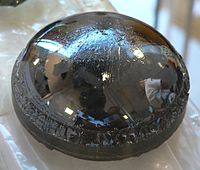
Photo from wikipedia
Abstract In this study, we used divinyl benzene (DVB) to modify a polycarbosilane precursor via chemical modification in order to fabricate homogenous graphene-like carbon-silicon carbide (C-SiC) nanocomposites. The electromagnetic interference… Click to show full abstract
Abstract In this study, we used divinyl benzene (DVB) to modify a polycarbosilane precursor via chemical modification in order to fabricate homogenous graphene-like carbon-silicon carbide (C-SiC) nanocomposites. The electromagnetic interference shielding effectiveness (EMI SE) of the composites was tested over the temperature range from room temperature (RT) to 600 °C in air. With increasing DVB content, the conductivity increased due to the lower degree of defects and the better connectivity of the carbon phase, whereas both the oxidation resistance and the EMI SE of the nanocomposites decreased. The results suggest that the degree of defects has a much stronger influence on the EMI SE than the conductivity. Possessing the highest degree of defects and best oxidation resistance, the C-SiC nanocomposites with a carbon mass percentage of 7.6 wt% showed the highest EMI SE both at RT and 600 °C, indicating that they are a promising candidate for an application as shielding material at high temperatures in air.
Journal Title: Journal of Alloys and Compounds
Year Published: 2017
Link to full text (if available)
Share on Social Media: Sign Up to like & get
recommendations!